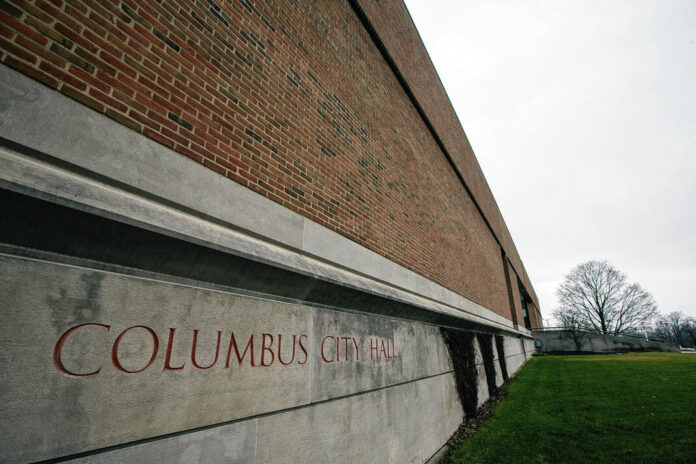New Columbus City Council districts are set to go into effect in 2024, despite some criticism from a watchdog group that follows redistricting efforts in Indiana.
The council has voted unanimously to approve the redistricting ordinance. The new district map can be viewed at columbus.in.gov.
All cities are required to review council district boundaries this year in consideration of the 2020 census. Additionally, the creation of a new, sixth district, is included in the amended map, because the council recently voted to adopt “second class” status for the city of Columbus, which will also go into effect in 2024. The transition entails a number of changes to city structure. One of the most notable is the addition of two new city council members.
Indiana’s second class cities each have a legislative body made up of nine members — six members representing six districts and three at-large members. Columbus City Council is now made up of five district representatives and two at-large.
Under the new map, District 6 will be located in central and north Columbus, with most of its area coming from the current District 4, as well as a small portion of District 3.
Additionally, District 5 will gain a couple of small portions of District 4. District 4 will gain some pieces of District 3. Some areas of District 5 and District 1 will now be located in District 3. District 1 will include some areas that are currently part of District 2, including downtown Columbus and a stretch of Jonathan Moore Pike from the East Fork White River to County Road 350W.
According to the approved ordinance, the 2020 United States Census counted a population of 50,224 for Columbus. The redistricting plan will enact the following changes within district populations:
District 1: Change from 9,542 to 7,824
District 2: Change from 12,337 to 9,135
District 3: Change from 8,601 to 8,316
District 4: Change from 10,454 to 8,645
District 5: Change from 9,290 to 8,503
District 6: New district with a population of 7,801
Councilman Frank Miller (R-District 4) said at Tuesday’s council meeting that while there has been some “questioning” of the city’s math or district sizes, the city’s math regarding district populations and the percentage of difference from the district average is correct.
He added that he and Councilman Tom Dell (D-at large) worked to follow Indiana Code during the bipartisan redistricting effort and had city attorney Alan Whitted check the statutes to ensure that they were in compliance.
“We’ve all put in a lot of hours with trying to be sure that this is done right and done right the first time,” said Whitted. “And we think that we have. We’ve, I’ve looked at all of the statute that’s listed in the ordinance. … You’d be surprised, but there’s really not any authority in Indiana that sets out exactly how this is to be done in any percentages. It’s all very vague.”
Indiana Code 36-4-6-3 states that the legislative body of a second class city must divide the city into six districts that “(1) are composed of contiguous territory, except for territory that is not contiguous to any other part of the city; (2) are reasonably compact; (3) do not cross precinct boundary lines, except as provided in subsection (c) or (d); and (4) contain, as nearly as is possible, equal population.”
In regards to the latter, Columbus’ population divided by six is roughly 8,371. Dell said in a previous interview that the city was required to ensure that each district’s population would be within 10% of the number that represents the city’s population divided by its number of districts. The new district totals are in line with that standard.
Dell said Tuesday that Bartholomew County Clerk Shari Lentz agreed that comparing each district population to that average was the correct way to ensure fair district sizes. Miller added that he believes Lentz also checked this information with Indiana Election Division co-director Brad King.
He told The Republic that the individual who questioned the city’s redistricting plans was Kelsey Kauffman, who leads a “watchdog” initiative called Indiana Local Government Redistricting.
“We just feel like her information is not soundly based on any code at all,” said Miller.
Kauffman had previously reached out to The Republic as well, writing in an email, “If the population figures you provided are accurate, then the population deviation of the new districts will be 16% — which is much higher than is allowed. Courts have consistently held that the population deviation must be less than 10% for local governments, with a target of less than 5%. Most second class city councils in Indiana are well within that range.”
Additionally, Kauffman’s website, indianalocalredistricting.com, includes a spreadsheet with information on second class cities and their redistricting efforts. The spreadsheet claimed that Columbus’ planned districts were not compact or contiguous and that its maps were “poorly drawn.”
The site is also critical of Bartholomew County Council and Flat Rock Hawcreek School Corp. districts.
According to the Statehouse File, Kauffman, a former DePauw University instructor, organized the college’s Local Government Redistricting Project, which discovered in 2012 that the North Putnam school system near Greencastle had “electoral districts with a wide deviation in population — one at 4,011 and another at 823.”
The Indiana chapter of the American Civil Liberties Union sued the school system on behalf of a local resident, saying that the disparity violated state law and the U.S. Constitution’s equal protection provision.
“The argument was that those in the districts with higher populations have their votes diluted in comparison to those in less populated districts, violating the principle of one person, one vote,” the Statehouse File reported. “Eventually, North Putnam switched to residential districts, meaning school board members are elected at large. That made the lawsuit moot, and it was dismissed in January 2014.”
The largest difference in district populations for Columbus’ new council districts lies between District 2 and the newly created District 6. Once the changes go into effect in 2024, District 2 will contain 1,334 more people than District 6.





